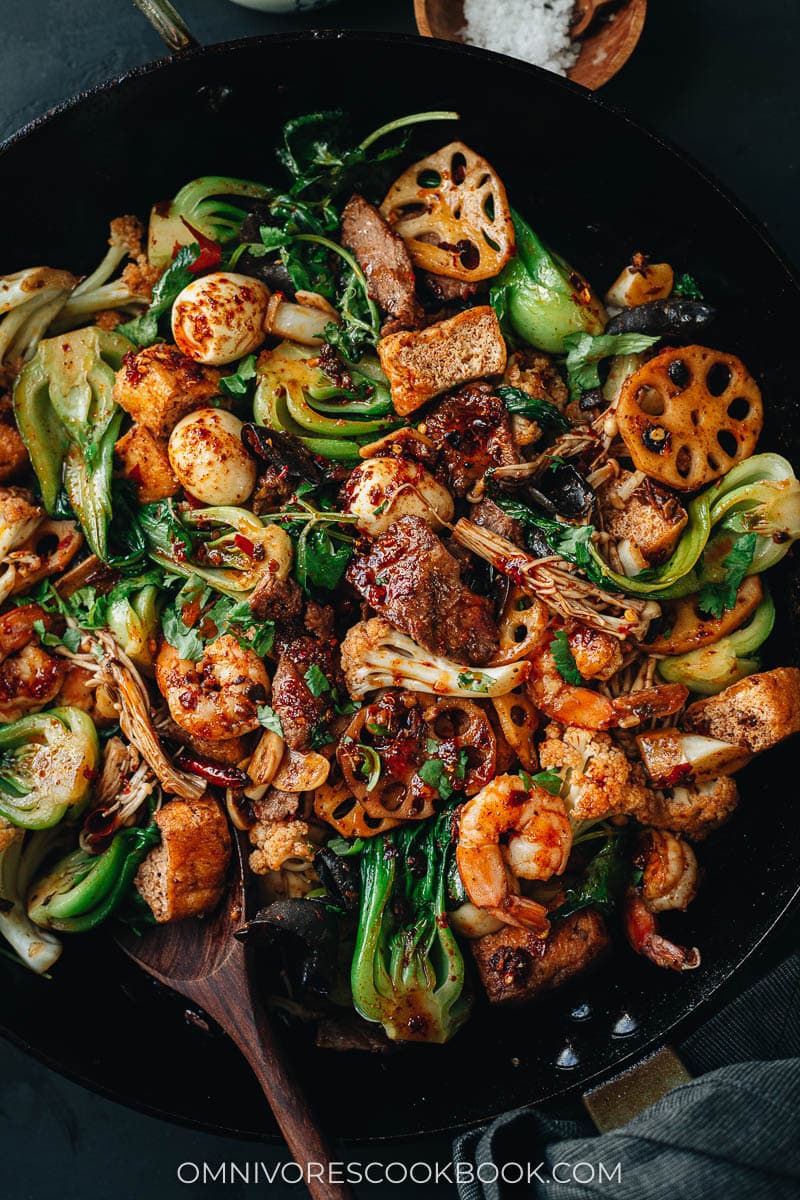
What is Ma La Xiang Guo
Ma La Xiang Guo (麻辣香锅) can be directly translated as “numbing spicy fragrant pot” and it’s often called spicy numbing stir fry pot or mala dry pot in the US. The dish features a medley of vegetables, tofu, meat, and seafood stir fried in a very rich and savory spicy sauce. It is often served in a giant bowl and shared family style over steamed rice.
The sauce is truly the highlight of the dish because it brings all the ingredients together and tastes addictively good. Every restaurant has their own secret sauce. But they share some common characteristics – they’re all numbing, spicy, fragrant, rich and balanced.
Ma La Xiang Guo originated in Chongqing and became very popular in China in the early 2000s. I remember thousands of Mala Dry Pot restaurants popping up, one on every corner. And it soon became one of my favorite destinations to grab dinner and a beer with colleagues after work.

How Ma La Xiang Guo is traditionally served
If you walk into a Ma La Xiang Guo restaurant in China, it might remind you of Chipotle. You will see arrays of ingredients neatly organized behind a counter covered with glass. To order, simply point out the ingredients you want in your pot. The waitress will start to add them into two big bowls, with vegetables and tofu in one and meat and seafood in the other. The price of the dish is measured by the weight. And you will choose the spice level you want – non-spicy, mild, medium, very spicy, or super spicy. Once it’s cooked, a giant bowl will be served in the center of the table, to share family style.
Ma La Xiang Guo is getting quite popular in the US these days too, and I’ve tried it at some very good restaurants in New York. One of my favorites is Mala Project, a slightly upscale restaurant that serves authentic dry pot in a chic ambience. I also happened to find a gem, LaoMa Spicy, a more toned-down place near NYU. They serve Ma La Xiang Guo the traditional way and it is a bit cheaper.
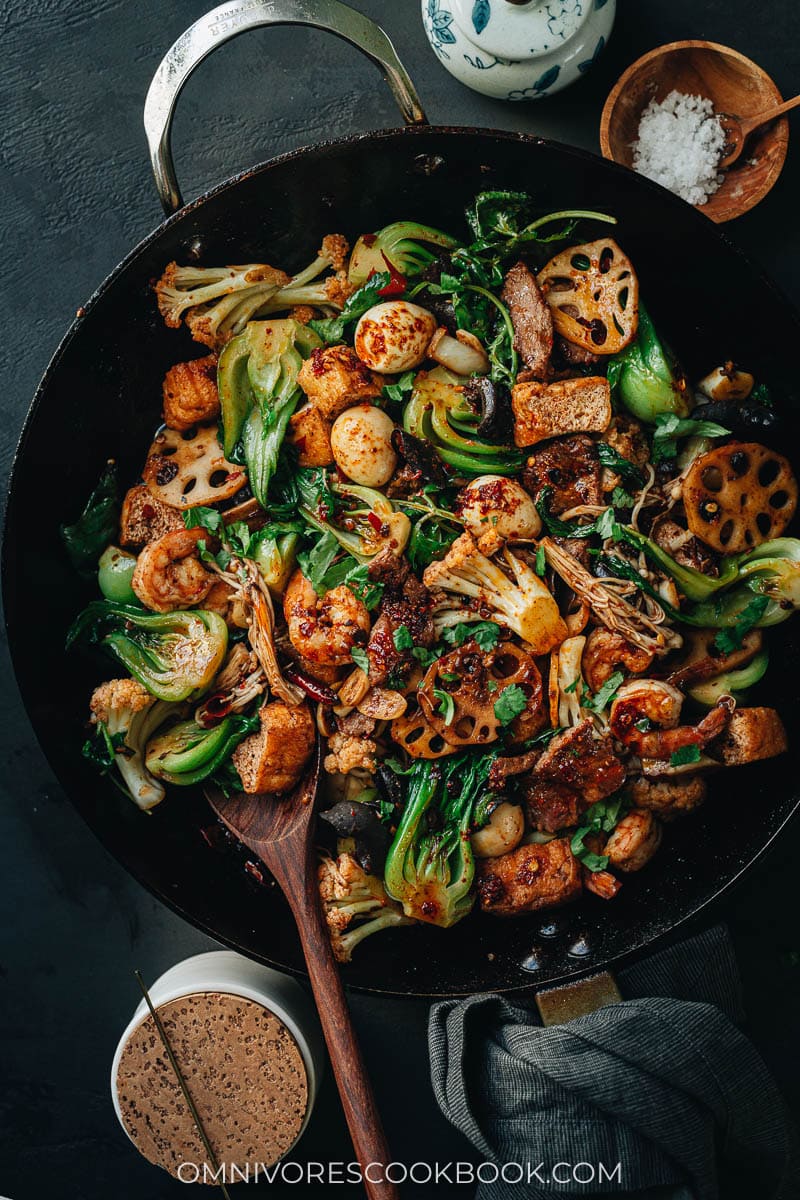
What ingredients are used in Ma La Xiang Guo
You can pretty much use any ingredients you want and still make a great Ma La Xiang Guo. The key is to select various ingredients that have different textures and tastes, so the final dish is more balanced and fun to eat.
Some of my favorite vegetarian ingredients include various Chinese greens, assorted mushrooms, things that add texture such as bamboo shoots and wood ear mushrooms, and tofu products.
For the meat / seafood part, my guilty pleasure is grilled chicken wings and Spam. I also like to add sliced fish or fish balls into my dry pot.
In China (and at very authentic restaurants in the US), you will find Ma La Xiang Guo menus offering a lot of innards. Ingredients such as chicken gizzard, beef tripe and tongue, and pork liver are commonly used and very popular.
Why this recipe
Making a great Ma La Xiang Guo is quite straightforward yet slightly tricky. You will need to:
- Cook a super flavorful sauce that is aromatic and rich in flavor
- Prepare the ingredients separately so each one gets cooked to the perfect degree
- Stir fry everything together with the sauce in a pan that’s big enough
The biggest challenge is to make a great sauce without using 20 ingredients. And to stir fry so many ingredients together without overcooking any of them.
After a lot of research and testing, I found out the great solutions to solve these problems:
- Use a good hot pot base as the main ingredient, then add doubanjiang and black bean sauce to make the most flavorful sauce with only 3 ingredients.
- Blanch the ingredients in groups instead of stir frying separately, so it’s fast and easy to prepare, plus you will use less oil in the final dish.
- Toss all the blanched ingredients together at the end with the sauce in a big pan. So you will be able to make this dish without using a wok.
Best Ma La Xiang Guo Sauce
The easiest way to create a great Ma La Xiang Guo sauce is to select a solid hot pot base, then add my two secret ingredients.
The hot pot base
For the hot pot base, I used Hai Di Lao Sichuan Spicy Hot Pot Base. Hai Di Lao is the most popular hot pot chain in China and their product quality is very good. Their spicy hot pot base is rich, but not too intense like some tallow-based ones. This brand is also quite easy to find in various Asian grocery stores and on Amazon.
If you really want to make things from scratch, you can use my homemade Sichuan Spicy Hot Pot Base. It contains less additives and no MSG.
Secret ingredients
I added Doubanjiang and Homemade Black Bean Sauce to the hot pot base. The result was amazing and truly like the dry pot you get at a restaurant! If you do not have homemade black bean sauce, a store-bought one works as well.
Many Ma La Xiang Guo recipes use a lot of spices to make the dish more fragrant. However, if you use a good hot pot base, it should already be fragrant enough. I find this shortcut makes cooking extremely easy and the result outstanding.
My choice of ingredients and how to prepare them
The fun part of Ma La Xiang Guo is the variety of ingredients. I went a bit overboard in this recipe and used nine ingredients by separating them into seven groups. I prefer to use one or two ingredients from each group for texture, but it’s totally up to you to add or reduce the variety.
This recipe requires the right amount of ingredients so your largest pan can hold them, and they will work perfectly with the sauce ratio. That’s why I created a list below, using cups and weight, to help you choose and swap out ingredients.
If you prefer not to use certain ingredients, you can replace them with different ones. For example, use more leafy greens and skip the mushrooms.
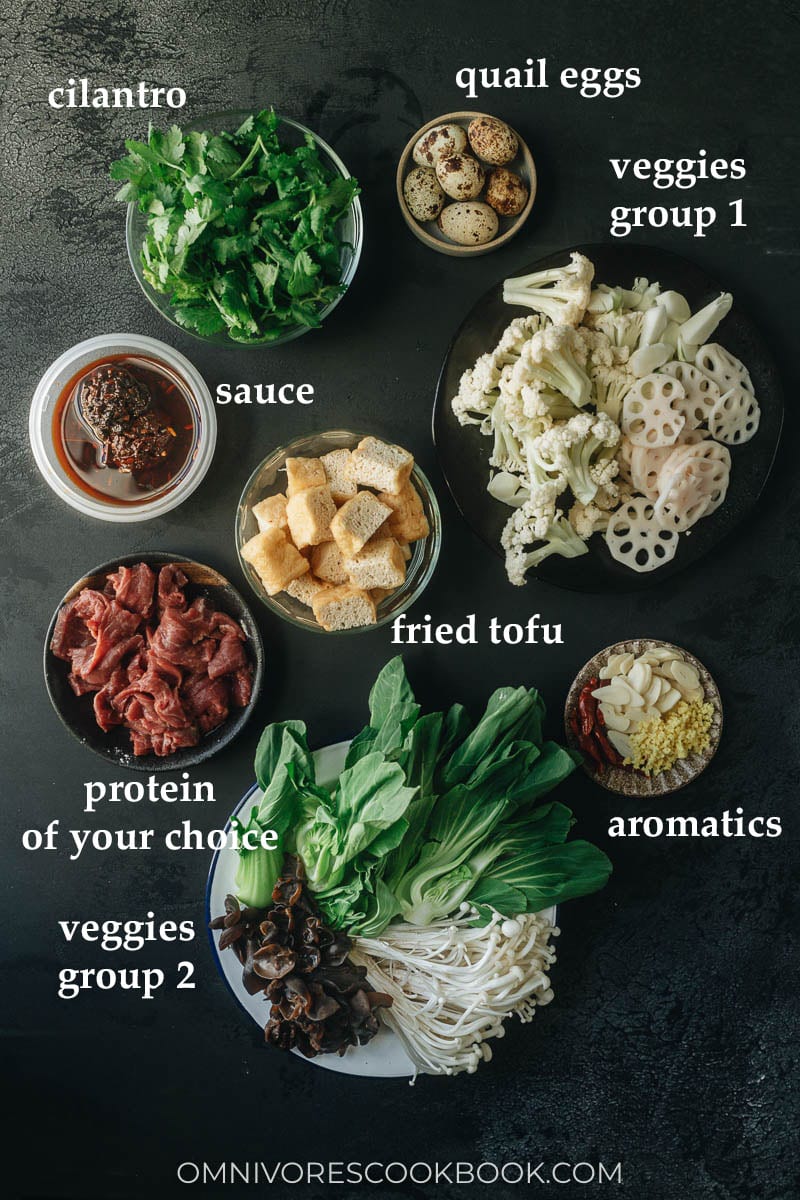
How to make this dish vegetarian / vegan
To make a vegetarian or vegan Ma La Xiang Guo, simply skip the meat and replace it with some other ingredients you prefer. I highly recommend using a variety of tofu products if you can find them. For example, yuba sheets or yuba knots, tofu skin, fried tofu and smoked tofu. They add great texture and taste to the dish.
How to prepare the ingredients
I’ve tried stir frying ingredients separately and blanching them, and finally landed on blanching except for the meat and seafood. Since you will be using a super strong sauce, the vegetables will be flavorful enough without stir frying them individually. This streamlines and simplifies the process a lot. Plus you will consume a bit less oil at the end.
For the meat and seafood, I do find that pan searing tastes much better. For fattier and higher quality meat, such as ribeye steak, chicken thighs, and shrimp, you can simply sear the meat. If using lean meat such as chicken breast, flank steak, or fish, I prefer to marinate them in a bit of Shaoxing wine and cornstarch so they will stay tender and juicy.
The formula to make Ma La Xiang Guo with any ingredient you have
| AMOUNT | INGREDIENTS | COOKING METHOD |
|---|---|---|
| 2 oz (1/2 cup, 50 g) | 1 tofu ingredient (tofu sheets, yuba, fried tofu) | blanch for 1 minute |
| 4 oz (2 cups, 110 g) | 1 leafy green (napa cabbage, bok choy, yu choy) | blanch for 1 minute |
| 6 oz (1 1/2 cups, 220 g) | 2 mushrooms (enoki , wood ear, oyster, king oyster) | blanch for 1 minute |
| 2 oz (1/2 cup, 50 g) | 1 starchy tuber (lotus root, potato, taro) | blanch for 2 to 3 minutes |
| 6 oz (2 cups, 220 g) | 1 crunchy vegetable (cauliflower, broccoli, celtuce) | blanch for 2 to 3 minutes, except celtuce which does not require blanching |
| 8 oz (220 g) | 1 to 2 meats/seafood (shrimp, thinly sliced pork belly, sliced beef steak, chicken thigh, cooked chicken wings*) | pan searing |
| 2 oz (1/2 cup, 50 g) | fun stuff (boiled and peeled quail eggs, bamboo shoots, fish balls, fish cakes, spam, sweet potato noodles, rice cakes, corn) | blanched accordingly; for Spam, pan fry until crispy; pre-soak dried noodles |
To sum up, you should use about 6 to 7 cups of vegetables, and half a pound (225 g) of meat in total.
How to cook Ma La Xiang Guo
The process for cooking Ma La Xiang Guo is super easy.
- Blanch the veggie group that needs more cooking time
- Blanch the tender veggies – some just need a very quick blanch
- Sear the meat
- Sear the seafood
- Saute aromatics
- Briefly cook the sauce base
- Coat the blanched vegetables and tofu with sauce
- Mix in the cooked meat and seafood
- Stir in the cilantro
That’s it!
The recipe looks a bit long but the process is quite straightforward. The result is so rewarding and tastes just like the restaurant version. You simply need to make some steamed rice and you’ll have a super delicious meal for four.
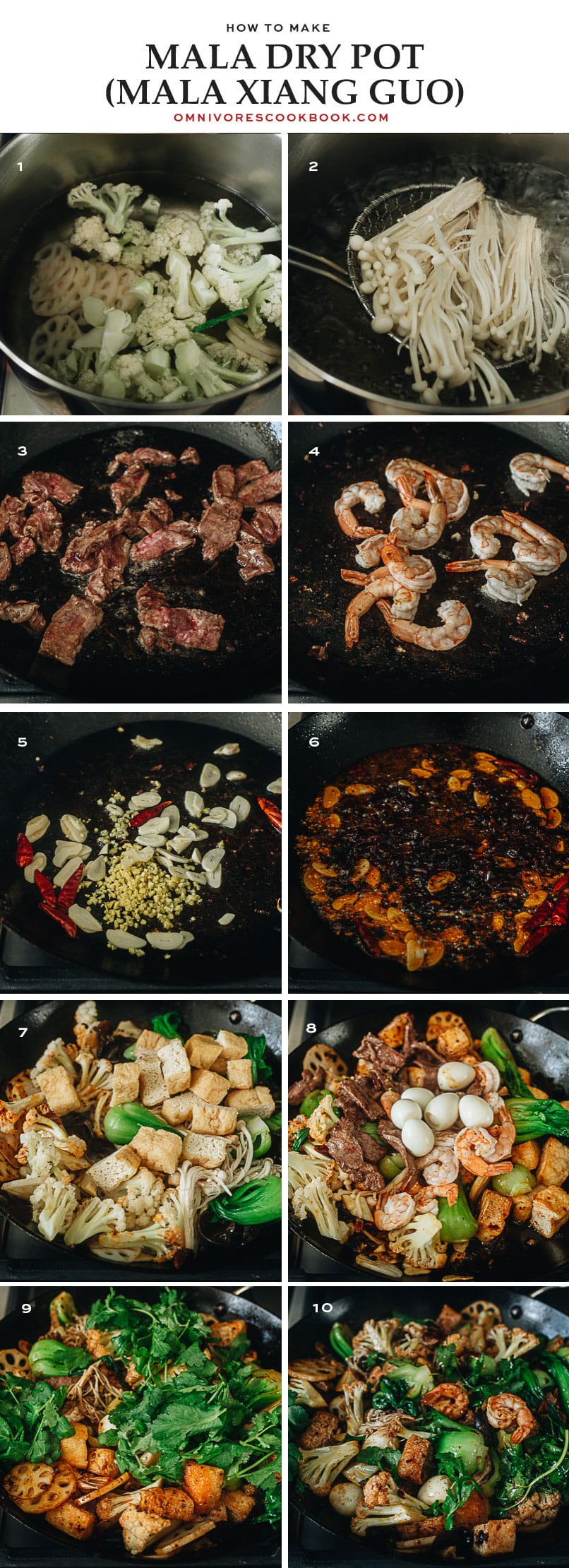
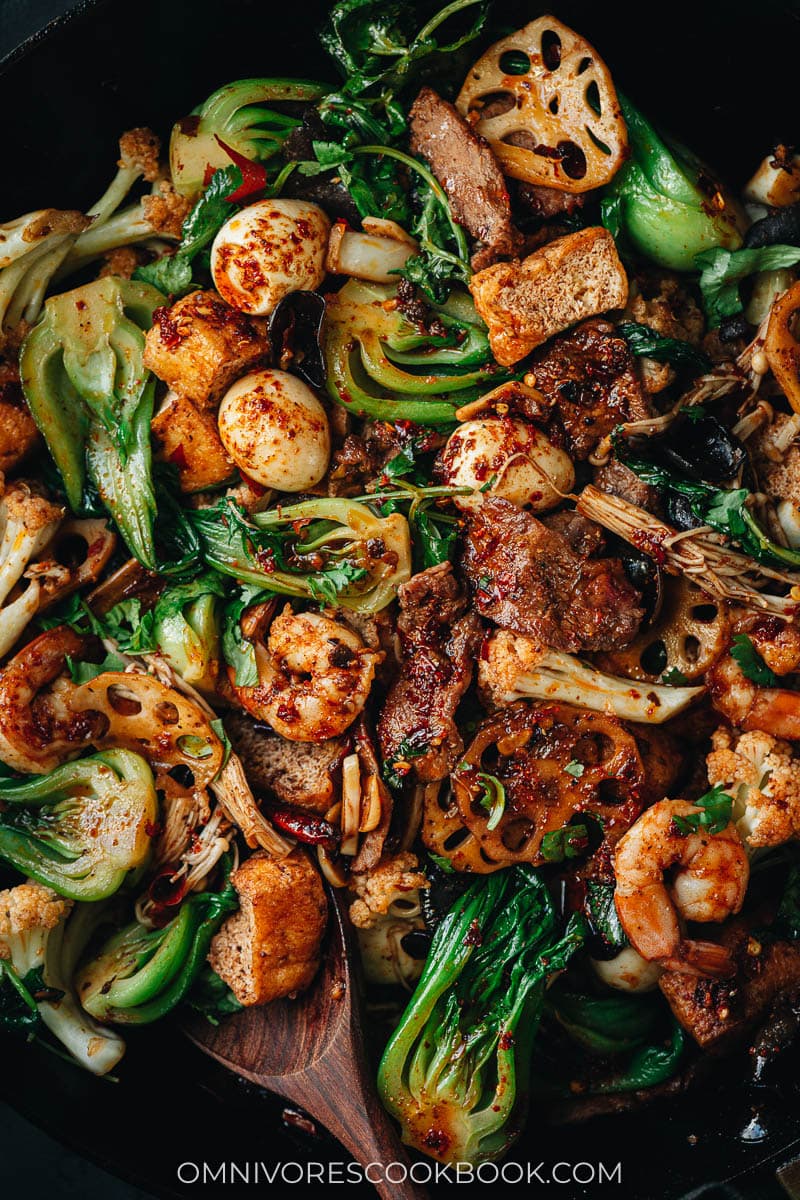
Afterthought
The beauty of Ma La Xiang Guo is, you can use pretty much any ingredients you like and the result is always good. I love to serve it at dinner parties because the pot includes so many things so everyone can find their favorites. It is also a great dish to make to clear out your fridge. I hope you like this one as much as I do!
Chinese Cooking Made Easy
Are you new to this website? This free email series is a great place to start. I’ll walk you through a few of my most popular recipes and show you how and why they work. You’ll quickly start to cook better Chinese food in your own kitchen.
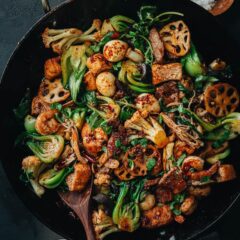
Ma La Xiang Guo (Sichuan Mala Dry Pot, 麻辣香锅)
Ingredients
Sauce
- 1/2 packet spicy Sichuan hot pot base (1/2 cup, 110 g) (homemade or store-bought)
- 1 tablespoon doubanjiang (or black bean sauce for a milder taste)
- 1 tablespoon homemade black bean sauce (or store-bought)
Dry pot ingredients
- 6 oz Chinese cauliflower (or regular cauliflower) , cut into florets (yield 2 cups)
- 2 oz lotus root , sliced (*Footnote 1) (yield 1/2 cup)
- 4 oz baby bok choy (about 6 heads)
- 4 oz enoki mushrooms (about 1 cup)
- 1/8 cup dried wood ear mushrooms (yield 1/2 cup after rehydrating)
- 1/2 cup fried tofu , cut to bite size pieces
- 4 oz strip or ribeye steak , thinly sliced (*Footnote 2)
- 4 oz shrimp , peeled and deveined (*Footnote 2)
- 2 oz quail eggs , boiled and peeled (about 1/2 cup)
Stir fry
- 2 tablespoons peanut oil
- 4 cloves garlic , sliced
- 1 tablespoon ginger , minced
- 6 whole dried chili peppers (or halved for a spicier taste)
- 1 cup cilantro , chopped
Instructions
- Prepare ingredients that need rehydrating: To rehydrate the wood ear mushrooms, add the dried mushrooms to a medium sized bowl and cover with 1 cup hot water. Soak for 15 to 20 minutes, or until the mushrooms are tender throughout. Drain, remove tough ends if needed, and cut into bite-sized pieces.
- For the sauce: Combine the sauce ingredients and set aside.
- To prepare the dry pot ingredients: Bring a pot of water to a boil for blanching non-meat ingredients (*Footnote 3). Set up a large strainer over a bowl. Blanch the ingredients in groups by timing or one ingredient at a time. Once done, transfer the blanched ingredients from the water and place in the strainer. First blanch the lotus root and cauliflower for 2 to 3 minutes, until al dente. Then blanch the bok choy, enoki mushrooms and wood ear mushrooms for 30 seconds to 1 minute, until just starting to turn soft.
- To cook the mala dry pot: Heat 1 tablespoon of the oil in a large skillet over medium heat. Spread the thinly sliced steak without overlapping. Cook for 30 seconds or until the bottom turns light golden. Flip and sear on the other side until just cooked through and the inside of the meat is still slightly pink. Transfer the meat to a plate.
- Add the shrimp to the pan. Cook for 1 to 2 minutes, until the surface turns pink-ish white. Flip and cook on the other side for another 1 to 2 minutes until the shrimp has fully curled up. Transfer to a plate with the steak.
- Add the remaining 1 tablespoon oil to the pan and the garlic, ginger, and chili peppers. Fry until fragrant, about 30 seconds.
- Pour in the sauce. Cook for another 30 seconds, or until the hot pot base is fully melted.
- Add the blanched ingredients. Toss a few times to coat well. Add the stir fried steak and shrimp. Toss until everything is evenly coated. Add the cilantro and give it one more toss. Immediately transfer everything to a large bowl or plate.
- Serve hot family-style as a main dish with steamed rice.
Notes
- If using raw lotus root, blanch for 3 minutes according to the recipe. If using pre-sliced and boiled lotus root, skip the blanching.
- If you use premium cuts of beef, chicken thigh and / or shrimp, sear them directly. For leaner cuts such as chicken breast, beef flank steak, and fish, mix every 4 oz. with 1 teaspoon Shaoxing wine and 1/2 teaspoon cornstarch to keep the meat juicy and tender.
- Meat ingredients can be blanched but will be less flavorful. Any other ingredient can also be individually stir fried, but for ease and speed of the recipe it’s best to blanch the non-meat ingredients.
Nutrition

Did you make this recipe?
I’d love to hear how it turned out for you! Please take a moment to leave a 5-star rating ⭐️ and share your thoughts in the comments further down the page. It really helps others discover the recipe too.
Other dinner party recipes
- Chinese Hot Pot Guide & How to Throw a Hot Pot Party at Home
- Shui Zhu Yu (Sichuan Boiled Fish, 水煮鱼)
- Baked Sichuan Chicken Wings
- Kung Pao Cauliflower
- Sichuan Roasted Whole Chicken
Lilja Walter was a part of the Omnivore’s Cookbook team and worked closely with Maggie to develop and test this recipe.

Dwi
Hi the link to the store-bought Sichuan hot pot base is broken, could you link again?
Maggie Zhu
I just fixed the link, you can also use this: https://amzn.to/41Z4wWj
Thanks for letting me know!
Anna
Hi Maggie! This recipe looks absolutely tempting and I plan on making it vegetarian. I have never worked with hot pot base, so I am not sure: there is no water in sauce ingredients, and it’s said that hot pot base should melt on the pan. So, no water added, right?..
Maggie Zhu
The hot pot base is quite saucy with chili oil. Sometimes, the hot pot base would solidify (depending on the type you use), and that’s why I used the word “melt”. But you’re right, there is no water needed in this recipe.
This is a great recipe for a vegetarian dish! Happy cooking and please let me know how it turns out 🙂
Anna
So, I have Hao Renjia hot pot soup base, bought it some time ago and never tried to cook with it. And apparently it was high on a spiciness scale, so I was a bit on fire;)) But I liked it! It was too Sichuan for my husband unfortunately, too numbing;)) Thank you for this recipe that allows me to try something similar to restaurant food, especially that there is not many authentic Chinese places around!
Maggie Zhu
Oh Hao Ren Jia is one of the very spicy ones! I would definitely use less. If you plan to cook it another time, I would reduce the hot pot base and increase the black bean sauce (Tian Mian Jiang, or sweet flour sauce, is another great option), which makes the dish less spicy. Anyhow, I’m glad to hear you still like it, and thanks for providing the feedback 🙂
May
Made this tonight as I wanted something super spicy for dinner to open up my congestion and it did the job! The flavor was great with the sauce hack, and I LOVE the table to mix and match what you have in the fridge. I swapped whatever was in my fridge and it was delicious. Definitely adding to my rotation!
Natalie
I absolutely loved this recipe! I didn’t add the bean paste because I didn’t have it and it turned out great! Will be adding to our meal rotation!
Anna L
I couldn’t afford my fav dry pot place anymore but was so happy to see that it’s pretty easy to make. Tastes just like the restaurant!
Andi Houston
I made this for dinner tonight: shrimp, gluten, bamboo shoots, cauliflower, sweet red pepper, onion, green onion, jalapenos, and lots of cilantro. Absolutely delicious and almost at my chile-heat tolerance, even with homemade black bean sauce.
Maggie Zhu
So happy to hear you like the recipe and thanks for leaving a positive review 🙂 It is a pretty spicy dish. If you prefer to make it milder, I would reduce the amount of the hot pot base and use more black bean sauce. Say, use 1/3 cup hot pot base, and increase the black bean sauce to 3 tablespoons.
Random
I have a heap of blocks of your Sichuan hot pot base I made … its honestly perfect , I used conola oil thought to be healthier , if you use your own base did you still add the doubinjiang and black beans? As the salt levels from the base seem perfect already … also do you know if this base is the same that is used for 小龙虾??。。。these are my 3 favourite dishes from my time living in china … if I can master all 3 my life will be complete… ( can’t praise your Sichuan base recipe enough, absolutely nailed it )
Maggie Zhu
I think you can use the hot pot base without adding doubanjiang. I do like the flavor of the black beans. That being said, if you like the hot pot base, it’s totally fine to use it without black beans.
小龙虾 uses pretty much the same base. The only difference is, you will need to add a can (or maybe more) beer after adding the sauce, and braise everything together to get the flavor in.